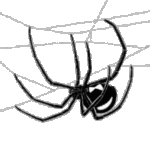Black widows are common spiders in the U.S and are generally found in warm, dry climates in undisturbed or uncommonly visited areas such as garages, woodpiles, attics, under sinks, closets, or any other dark remote areas. (Stoppler, 2006). People in the United States and in the southern region of Canada are at a risk for getting bit by the Black Widow spider, especially those in rural or suburban areas. (Healthwise, 2006). Luckily vigilance is a good way to avoid experiencing the wrath of these notorious spiders. Black Widow spiders, like many creatures, only bite when they feel threatened. Disturbing their habitat, webs, or messing with the spider can yield a bite in no time at all.
So what can you expect from a Black Widow bite? What can you do? Symptoms can be very serious, especially in children and the elderly or with those that have an allergic reaction. The initial bite is said to be minimally painful, at times Black Widow bite victims don’t even know that they have been bitten until symptoms arise. If it is felt it is likened to the feeling of a pin-prick and victims can generally see the sign of double fang marks at the site of the bite. Immediate symptoms include pain, burning, swelling, and redness. The pain generally extends up and down the length of the site area eventually causing a localized pain in the abdomen and back. (Hedding, 2007).
Black Widows spiders are characterized by the red hourglass symbol located on their underbelly, and inject what is called a Neurotoxin into its victims. Neurotoxins affect the neuromuscular junctions causing chest and abdominal pain, breathing difficulties, heart palpitations, nausea, vomiting, sweating, fever, increased blood pressure, and rash; all of which can result from the Black Widow bite depending on the site of the bite, the amount of venom injected, and the age and health of the victim. (DermNet, 2006). Symptoms generally appear within a range of 30 minutes to 3 hours after the bite.
One of the most important things in dealing with a bite, especially a spider bite, is to make sure you identify the spider. Unfortunately, spider bites like Black Widow bites in which pain upon injection of venom isn’t always immediately evident, this may be impossible. However, if you see or can catch the spider that bit you, it can greatly help medical professionals treat your condition, and help you to take the proper action right away. In any case, there are steps you should take after any bite, and specialized steps for a Black Widow bite.
In the event of any type of bite, it is important to wash the site of the bite thoroughly. Use soap and water when washing and then apply a cold pack or cloth to the site. This should help in the swelling, and a dose of ibuprofen (found in Advil and the like) can be taken to help deal with the pain. Whatever you do, do not give aspirin to anyone with a spider bite, choose an acetaminophen or ibuprofen medication. (Stoppler, 2006). In the meantime, it is extremely important to contact a medical professional for a Black Widow bite, or a bite that is unidentified. Antivenin is available for Black Widow bites, as well as treatments of intravenous calcium gluconate used in an alternating pattern with methocarbamol to relieve tight and painful muscle cramps. (DermNet, 2006). The good new is that deaths from Black Widow bites are highly uncommon, the California Poison Control reports that deaths from Black Widow bites haven’t occurred in over ten years. (California Poison Control, n.d).
At the hospital be prepared to explain in detail to the doctor what happened, be able to describe the spider (if possible), describe the pain or whatever you are feeling, tell the doctor where the bite happened (i.e. garage, basement, etc…) Any and all information you can provide can help the doctor to diagnose the bite if you don’t know what it is, or treat the bite and your symptoms.
While Black Widow bites may not be fatal, they can be serious, painful, and cause a great deal of health complications to the victim. It is important to take the appropriate steps after being bitten and know what you can do to help a bite victim to ensure that they are well taken care of and no serious adverse effects result from the bite (such as convulsions). Education is key in preventing and treating spider bites. Black Widows are a part of the U.S and are common to see and have to deal with, it is thus important to know where you might find them, what sort of affects a bite has, and what you can do after being bitten.
References:
California Poison Control. (n.d). Spider Bites: Black Widow Spider. Retrieved April 3, 2007, from California Poison Control System Website: http://www.calpoison.org/public/spiders.html
Stoppler, M.C. (2006). MedicineNet. Retrieved April 3, 2007, from MedicineNet Website: http://www.medicinenet.com/script/main/art.asp?articlekey=61266
Hedding, J. (2007). How to Treat a Black Widow Spider Bite. Retrieved April 3, 2007, from About Website: http://phoenix.about.com/cs/desert/ht/blackwidow.htm?terms=spider+bite+treatment
HealthWise. (2006). Black Widow Spider. Retrieved April 3, 2007, from WebMD Website: http://www.webmd.com/a-to-z-guides/Insect-Bites-and-Stings-and-Spider-Bites-Topic-Overview
DermNet. (2006). Spider Bites. Retrieved April 3, 2007, from DermNet NZ Website: http://www.dermnetnz.org/arthropods/spider-bites.html




